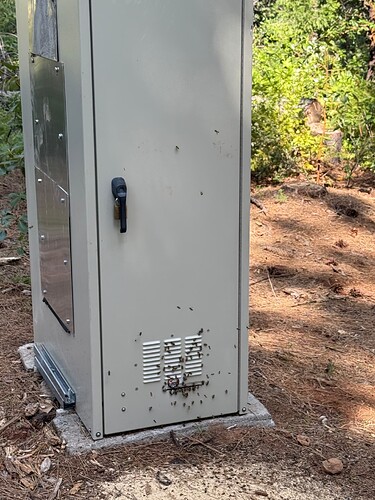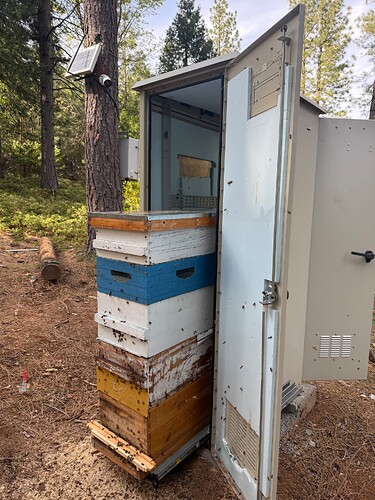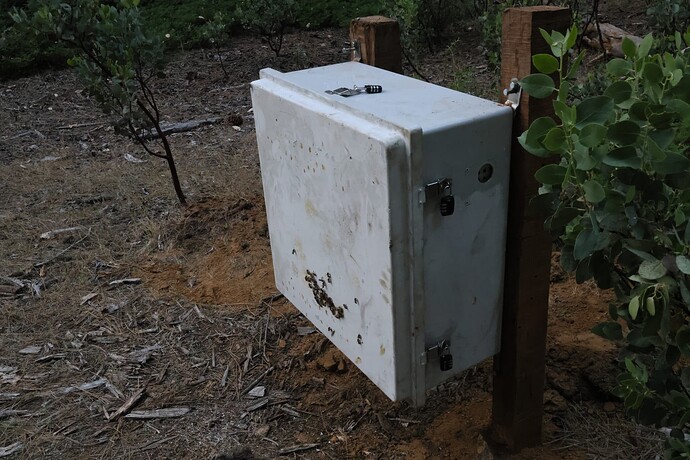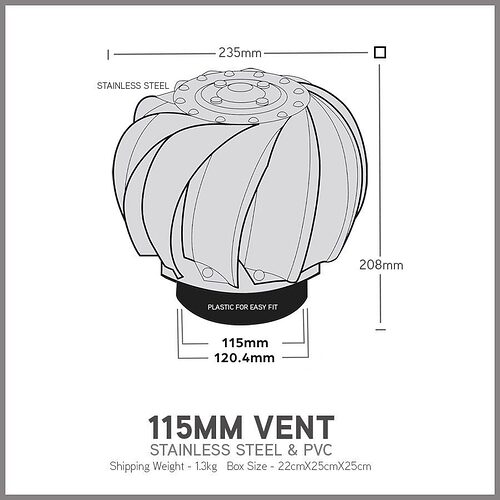In effort to keep my bees on my timber property I used some network enclosures and they work great so far….. I’m worried that it may get too hot in the summer. Has anyone done anything similar that can give me some tips or share their experiences. These bees are in the middle of the forest. I had to install another hive across the property so that queens can mate when needed. I’m not sure if that will last long since its can only bee a brood box.
If the sun shines on that, I would expect it to function similar to a convection oven.
In which case, there are some options. It might seem counterintuitive, but you could use some 2" thick roofing insulation foam (the stiff type that comes in boards) and duct tape it around the outside of the housing, leaving a way to undo it and inspect (required by state regs in CA). I would leave openings for the vents on the housing too.
If possible, paint it white to reflect heat, and your bees will provide a swamp cooler effect inside the enclosure by gathering water and fanning.
Using this approach the white paint will reflect some of the radiant heat, and the insulation will moderate the inside temperature to help the fanning effects of the bees.
Just a thought! ![]()
Thank you for the ideas. I agree it could be insulated more than it already is. On the inside, foam board insulation is glued to the walls and door. It comes that way from the factory. I’m in bear country, so anything like foam board on the outside will just get destroyed. I have one bear that checks the integrity of the enclosure multiple times a week. Maybe I can line the outside with a wood panel similar to a house and paint it white.
I think that’s such a clever idea. I see the sliding rails makes for easy hive access.
As for excess heat prevention, removing hot air from inside the enclosure is as important as minimising heating the inside, like roof vents in a house. Maybe something like this, though I don’t know how it would stand against bears.
Thank you Mike, I think you’re on to something, simple but effective. I’m going to do some research to find available sizes and ways I can mount one of those things. With some luck, I can install it on the side where I covered the refrigerator unit opening. I’d be afraid of going into the top, potentially creating leaks in the winter.
Today, I ordered two temperature data loggers designed for shipping cargo that will tell me what I’m really up against. I’m going to place one outside the enclosure for reference, but I don’t know where I should be concerned about the other temperature. In the hive or the enclosure? Maybe both?
I would place it in the enclosure. The bees will deal with the hive temp, if they have enough population and enough water nearby. The brood nest temp will be pretty constant at 35°C and you don’t want to mess with that. The super can vary quite a bit from that, but what really matters is the temperature gradient the bees have to work with outside the hive. Once outside gets much above 42-45°C, the bees will have a really tough time with cooling, as Forum members in Arizona found one hot summer a few years ago.. ![]()
P.S. I apologize for using °C, but I am basing my numbers on my measurements from an Arnia hive monitor which I installed some years ago. Their monitors gave all readings in °C ![]()
Now you’re sounding like a scientist. Measure the conditions, so you know what you’re dealing with. It’s the basis of integrated pest management. Measure mite levels, treat if at or above threshold, measure again to check effectiveness.
By monitoring inside and outside the enclosure (not the hive, as Dawn said), you can directly measure the effectiveness of your solution i.e. insulation, active and passive ventilation.
Sounds like a fun project to me. Please post your findings.
Mike
Ill update my findings.
I learned the company that makes the cabinets has already implemented methods for easy temperature management. Some come installed like the special roof that keeps the internal temp 10-12 degrees cooler than if not installed. And 2 fan cutouts on the top for a optional fan kit with thermostat.
How would you get power to it? Very interesting concept, though, well done! ![]()



